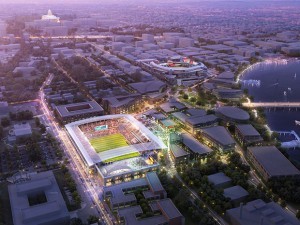Mayor Gray’s updated deal for a soccer stadium is crystal clear about one thing — the city will spend no more than $90 million to acquire land for the stadium. But everything else about the way that land in Buzzard Point would be assembled is incredibly confusing, and it is not clear whether the plan is the best deal for the city.
The agreement includes a complex series of land swaps rather than straight up land buying and selling. The city does not have enough money to purchase the stadium site, and it is unclear what other land and funds will be needed to complete the transaction. However, it is clear that the plan would treat the Reeves Center like a property in Monopoly — to be traded for cash and land — rather than taking into account its role as a public asset in the center of the city.
For these reasons, it will be important for the Council to consider the land swaps carefully as it takes up the soccer legislation.
Under the agreement, the District would acquire the needed parcels for the stadium by trading DC-owned land to private landowners at Buzzard Point. According to the exchange agreement, the District would trade the Frank Reeves Municipal Center, at 14th and U Streets NW, to the DC developer Akridge for two acres at Buzzard Point. The agreement, based on appraisals by the City Administrator and Akridge, values the Reeves Center at $56 million. Akridge’s land is valued at $21 million, so the company would pay the District $35 million in cash.
However, the rapid development of the 14th and U Street corridors suggests the District could possibly get far more if the Reeves Center were sold to the highest bidder. The Washington Post reports that the Reeves Center was assessed at $186 million by the Chief Financial Officer in recent years and that the $56 million Akridge would pay is $13 million below the most recent assessment. Moreover, the stadium deal would allow Akridge to knock $9 million off the Reeves Center price tag if it turns out that federal Davis-Bacon law applies to the property’s redevelopment.
In addition, the deal would generate no more than $56 million for the city, yet it is not clear where the remaining $34 million to acquire other stadium parcels would come from. Part of the transaction could be to trade District property at 1st and K street NW to utilities company PEPCO.
Finally, there is no indication that the deal between the District and Akridge incorporates input from the Reeves Center’s neighbors as to whether it should be sold or how it should be redeveloped. It appears that Akridge could develop the land any way they want.
If the District is to get the most out of redeveloping the Reeves Center, it should consider setting terms for how the property is used that take into account the city’s needs and the desires of the community. Once those terms are set, the building could be sold to the highest bidder to ensure that the transaction is transparent and gets the best value for the District.

